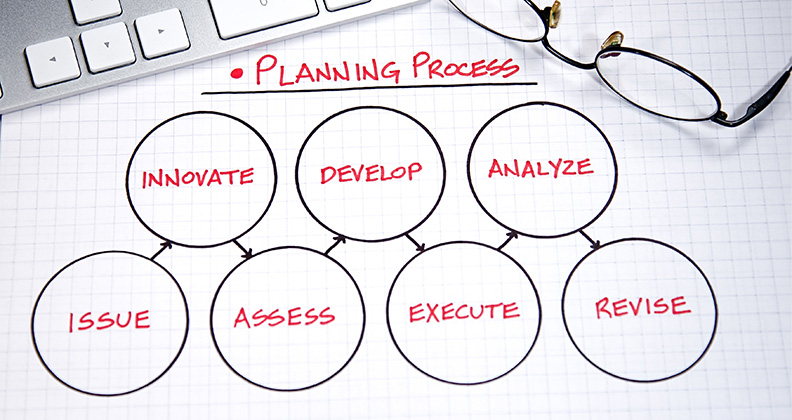
Jeremiah Hammon, PMP, believes project management is the engine that drives strategy into results.
“Strategy is a hypothesis, a theory about what you believe will happen,” said Hammon, Co-founder of Project Revolution, a consulting firm that focuses on developing productivity and leadership skills. “Project management creates the frameworks that detail how you will execute strategy.”
Each stakeholder involved in a project might have different ideas about the best way to implement the framework. Hammon said project managers must work to integrate these diverse perspectives and create synergy to ensure the project is completed successfully.
“Project managers step in to connect the dots, grounding the business case in practical terms,” he explained. “They distill the chaos and noise of multiple stakeholders into a clear, executable plan.”
Hammon noted that project managers have a choice to make when faced with a new set of directives to implement: They can choose hard work, guesswork — or frameworks. When frameworks are in place, a project is easier to manage and most of its success is based on effective leadership.
“It’s about communication and getting people aligned on what needs to be done and when,” Hammon said. “Then, you look at intrinsic motivators. How do you inspire people to deliver what’s needed and on time? You can have all the processes and frameworks in place, but if you can’t communicate effectively, people won’t execute efficiently.”
Establishing the Scope
Start from the top down. What’s the business case for the project? What are you trying to accomplish and why? What structures are needed to make it happen?
From there, determine the milestones or checkpoints that guide your team toward the goal. “That’s crucial,” Hammon said. “Once you’ve clarified the business objective, the next step is determining the right methods, tools and frameworks needed to achieve it.”
One of the first things you need to determine is the project’s life cycle, which is made up of various phases. “Once you understand the phases, you can work backward from the goal to set a process to achieve it,” Hammon said.
After establishing the life cycle and important milestones, decide which project management approach to take. The waterfall model involves working through a series of linear and sequential steps. It’s traditional and predictive, and best suited for well-established projects with little variability. Team members typically focus on following the established process because that is what’s deemed essential.
An agile approach is more adaptive and flexible, allowing teams to respond to changing business conditions. Agile project management emphasizes delivering value to the customer instead of sticking to the original scope of the project. When projects hit a bottleneck, an agile team adjusts on the fly to keep it moving forward.
“A hybrid approach includes elements of the waterfall and agile models and is often the most effective,” Hammon said. “It combines the predictability and foresight of a predictive model while allowing for the flexibility to adapt in the present. You stay on track with milestones while remaining agile in the moment.”
That’s where the mindset shift happens, according to Hammon. “In an agile or hybrid environment, flexibility becomes part of the methodology,” he said. “However, you need to put small protocols in place to ensure that flexibility isn’t misused. Maintaining a balance between structure and adaptability is essential.”
The triple constraints of project management — scope, schedule and cost — can help guide your decision-making in the moment. “It’s a powerful tool for problem-solving,” Hammon said. “When faced with challenges, understanding how a project’s scope, schedule and cost interact helps you make better choices.”
Maintaining quality standards in project management is non-negotiable, especially in orthopedics. It requires paperwork and regulatory documentation at every step of the way. “You’re not just delivering a product,” Hammon said. “You’’e delivering a comprehensive set of documents to meet regulatory standards.”
A project’s budget and timeline are, of course, key concerns. How much will it cost? Who’s funding it? How much time do you have to complete it? What are the milestone deadlines? How do all these factors tie back to the quality requirements?
“Once you have this basic framework in place, it becomes easier to walk through the entire project systematically,” Hammon said. “You can break down the scope of the project using this approach.”
Teamwork and Communication
When the planning is done, you need to understand how you’ll execute the plan and communicate it effectively and consistently to the stakeholders involved in the project.
Scrum is one of the best communication strategies for project management that drives great results, according to Hammon. It involves completing small chunks of work and daily check-ins with team members.
Project managers also need to know their strengths and channel them consistently. Hammon referenced Daniel Goldman’s work on emotional intelligence. “To effectively lead others to the highest level, leaders must first understand themselves,” he said. “This self-awareness helps them communicate more effectively with others.”
Regardless of which project management framework you choose, the concepts are relatively easy to grasp and apply. But frustrations could begin to mount when projects don’t progress as quickly or as smoothly as you’d like. Bruce Tuckman’s stages of team development offer a framework for understanding how projects might not always play out as expected.
Hammon said teams are often excited and engaged about a new initiative during the project’s initial steps. Tuckman calls this the forming phase. But teams eventually hit the storming phase, during which they start to realize what they don’t know. That’s when frustration could set in.
“Team members feel overwhelmed and question whether they can learn the skills needed to complete a project,” Hammon said. “Leaders need to be aware of this potential development. Project management frameworks are easy to understand but harder to execute.”
The best thing a project manager can do is to understand both the complexity of the project and the skill set of the team, Hammon noted.
“If you consider these factors when onboarding team members, you can assess where they stand in terms of their project management experience,” he said. “As a leader, you need to know your team inside and out. Planning the make-up of your team should be as important — if not more so — than planning the project itself. Ultimately, you want to be able to delegate tasks confidently, hold meetings and let your team members show up and perform.”
DC
Dan Cook is a Senior Editor at ORTHOWORLD. He develops content focused on important industry trends, top thought leaders and innovative technologies.




